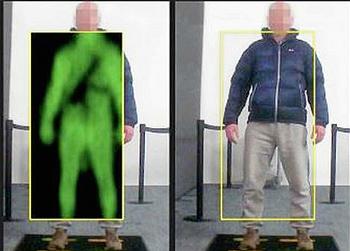
LOS ANGELES, California, August 22, 2018 (ENS) – Body scanners to detect weapons and explosives that could cause a mass-casualty event will be the new normal on the Los Angeles subway system shortly, as L.A. becomes the first U.S. mass transit system to install the devices.
The scanners can detect both metallic and non-metallic objects, such as plastic explosives, 3D printed guns and ceramic knives, on a person’s body from 30 feet away, according to Thruvision, the UK-based company that makes the scanners.

The Los Angeles County Metropolitan Transportation Authority, or Metro, says the devices are capable of screening more than 2,000 passengers an hour without slowing their progress through a subway station.
“We’re dealing with persistent threats to our transportation systems in our country,” Transportation Security Administration, TSA, head David Pekoske told the Associated Press. “Our job is to ensure security in the transportation systems so that a terrorist incident does not happen on our watch.”
Following a series of tests over the last year of TSA-vetted and approved security technologies at its stations, Metro has purchased several Thruvision TAC-TS4 portable terahertz millimeter wave passenger screening devices.
Thruvision technology unobtrusively detects concealed weapons, explosives and contraband hidden under peoples’ clothing in crowded environments such as airports, train stations concert halls and public buildings.
Based on patented TeraHertz imaging research work completed by the Rutherford Appleton Laboratory and the European Space Agency, Thruvision is a people-screening camera that allows a user to see any type of item hidden in clothing at a distance greater than five meters (16 feet).

This high throughput, stand-off people-screening technology can screen up to four people simultaneously in a way that Thruvision says treats travelers in a “safe and respectful way.”
The devices identify objects that block the naturally-occurring waves produced by a person’s body. When an object is hidden in clothing or strapped to a person, these waves are blocked and detected by the system’s software.
The software generates generic avatars and creates either a black spot on the area of the body where the item is concealed or overlays a color indicator.
The technology does not emit radiation of any kind and no anatomical details are displayed.
The scanners are compact in size, allowing for flexible deployment. With no physical search of a person needed, they have a screening time of just eight seconds per person and offer full-body screening with no blind spots. The scanners detect all types of material, and objects as small as 5cm x 5cm (10 x 10 inches).
“We’re looking for explosive vests, we’re looking for assault rifles,” Alex Wiggins, who runs the Los Angeles County Metropolitan Transportation Authority’s law enforcement division, told the AP. “We’re not necessarily looking for smaller weapons that don’t have the ability to inflict mass casualties.”
Wiggins said the scanners would be deployed only after employees and police officers had been trained in their use. Thruvision calls them “intuitive and easy for security staff to use.”
The scanners are moveable from place to place. The company says this enables flexible, mobile deployment as part of a “pop-up security screening approach.”
Thruvision says the scanners are suitable for use at a wide range of venues: sports stadiums, entertainment venues, conferences, outdoor festivals, museums and galleries, public buildings; at national borders; and at transportation sites such as: railway stations, subway stations, coach stations, airport concourses and ferry terminals.
“TSA applauds the leadership of L.A. Metro for its proactive efforts to evaluate, procure and use state-of-the-art technology designed to detect potential threats to the transit system,” said TSA Administrator Pekoske. “TSA is pleased to have been a partner during the evaluation and testing process, which ultimately led to the purchase of a recommended system to help detect and deter potential acts of terrorism while keeping the traveling public safe.”
Copyright Environment News Service (ENS) 2018. All rights reserved.
© 2018, Environment News Service. All rights reserved. Content may be quoted only with proper attribution and a direct link to the original article. Full reproduction is prohibited.
